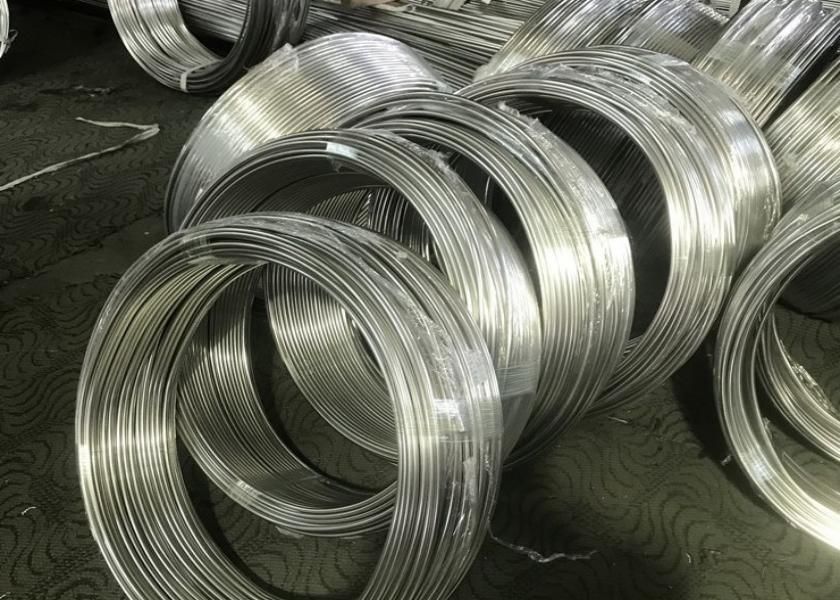316L stainless steel 10*1mm coiled tubing
Additional Information on 316L Stainless Steel
316L stainless steel 10*1mm coiled tubing
Another widely used austenitic steel is 316 and 316L stainless steel, the corrosion performance of SS 304 is not enough, 316L is often consider as the first alternate. The higher Nickel content in 316 and 316L over SS 304 and the Molybdenum addition in 316 and 316L gives it an edge in performance in corrosive and high temperature environments.
As with 304 and 304L, the difference between the 316 and 316L grades is the quantity of carbon contained. The L stands for low carbon, both L grades contain a maximum 0.03% carbon, while the standard grades can comprise up to 0.07% carbon. It may not seem like a big difference, but it means that L grade versions of stainless steel alloys suited better for the larger welding projects. The lower Carbon content of L grades reduces cracking in the heat affected zones of welds and improved weld quality.
Stainless Steel 316 Chemical Composition – Chrome and Nickel
316L stainless steel 10*1mm coiled tubing
As with the 304 grade, 316 stainless steel owes much of its corrosion resistance to its chromium content. The passivated chromium oxide film which develops on the surface acts as a protective barrier against corrosion. It’s the chromium in the 304 and 316 grades that differentiate stainless steel from carbon steel.
The chemical composition of stainless steel 316 is almost identical to that of the 304 grade. There are a few distinct differences with the quantities of chromium (18 – 20% for 304, 16 – 18% for 316) and nickel (8 – 10.5% for 304, 10 – 14% for 316).
Molybdenum Content of Stainless Steel 316L
316L stainless steel 10*1mm coiled tubing
Also, 316 stainless steel contains between 2 – 3% molybdenum to give it its chloride-fighting properties. Molybdenum is a key ingredient in 316 stainless steel because it prevents small carbide particles that weaken the Chromic Oxide layer on the surface of the steel from forming at grain boundaries of the base metal.
316L stainless steel 10*1mm coiled tubing
The corrosion resistance of molybdenum-bearing 316L austenitic steel is particularly effective in chloride-ion environments. The molybdenum component prevents chloride ions pitting the and crevassing the surface of the steel. The presence of molybdenum makes 316 a good material for marine environments for the oil and gas industry. Even with the Molybdenum addition, 316 stainless steel is not entirely immune to sea corrosion. Warm seawater can corrode the surface of 316 grade marine parts over time, leaving the finish stained brown and rough. However, with careful maintenance the finish can be restored to its original clean, bright condition.
316L stainless steel 10*1mm coiled tubing
The molybdenum in 316L stainless steel also protects it against aggressive, acidic environments. 316 stainless steel offers superior protection against hydrochloric, acetic, tartaric and sulfuric acids. This makes it ideal for food processing and paper handling operations. This grade also resists corrosion from de-icing salts added to the roads.
316 Stainless Steel Properties & Applications
Like its 304 grade counterpart, 316 stainless steel is non-magnetic and will not harden under heat treatment. It has excellent drawdown workability and holds a better strength at higher temperatures than the 304 grade. It also offers high resistance to chlorine-induced stress corrosion cracking. This usually occurs at temperatures above 140° F. The 316 grade also remains structurally strong even at sub-zero temperatures.
The stainless steel 316L can be supplied in a variety of forms, including sheet, bar, plate, rod, and tube. It looks very similar to 304 stainless steel, and the two can only be differentiated by material testing.
316 stainless steel was once the main choice for medical implants. These days titanium, which offers better biocompatibility, is preferred.
For a little extra cost, 316L stainless steel offers greater strength and durability in chloride-ion environments than the 304 grade.
Common applications include pressure vessels, heat exchangers, exhaust manifolds and food preparation equipment. You’ll also find it used for chemical processing and laboratory equipment, condensers, and evaporators.
The keen resistance of 316L stainless steel to potable water and the alkalis and acids in food, make it ideal for use in restaurant kitchens. It comes in a range of attractive finishes and withstands repeated cleaning well with detergents. As such, the food and beverage industries are major customers. Speak to one of our representatives to learn more.







